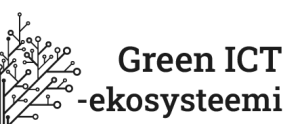
ICT is ubiquitous – it is everywhere, in everything, all the time – a part of and impacting all spheres of modern life and work. ICT products and services have vast potential to generate powerful and far-reaching environmental benefits when developed and used in a way that is mindful of the climate. The following findings of this project show that it is possible to engage in Green ICT sustainably.
- Green ICT stands for leveraging ICT to solve the challenge of sustainable development, preserving the planet’s ecosystem in the face of anthropogenic climate change and natural environment degradation. Green ICT leverages ICT to build a better, greener future, decreasing the carbon footprint of ICT-induced digitalisation while enhancing its handprint. Read more in Chapter 1.
- The carbon footprint of the ICT sector (green or otherwise) represents the usage of resources and energy, and the production of emissions and waste, linked to the production, usage, and disposal of ICT products and services. Due to ever-increasing digitalisation occurring in all spheres of human activity, the ICT sector’s negative impact on the climate and the environment will also increase, if not consciously managed. Read more in Chapter 2.
- The carbon handprint of the ICT sector represents the positive effects ICT has on emissions and material consumption in its usage or deployment. It refers to the indirect benefits that ICT solutions deliver to the environment via reduced emissions in the associated area. Green ICT can potentially boost the handprint of ICT in a significant, measurable way. Read more from Chapter 3.
- Green ICT R&D refers to the research and development activities aimed towards creating, enhancing, and promoting innovative technologies, methods, and practices that aim to reduce the overall negative environmental impacts of the ICT sector. These efforts are focused on improving energy efficiency, reducing emissions, and minimising the usage of hazardous materials in the production, usage, and disposal of ICT systems. Read more in Chapter 4.3.
- Green ICT opportunities for businesses include improved efficiency, costs (savings), competitive advantages, regulatory compliance, innovation, and new business opportunities stemming from innovations. All opportunities in Green ICT remain within the sphere of sustainable development and, by extension, help achieve corporate social responsibility goals. Read more in Chapter 4.
- The Green ICT Ecosystem is a dynamic network of stakeholders, technologies, policies, and practices focusing on reducing the environmental impact of the ICT sector. The stakeholders involved are policymakers, industry players, academic researchers, and end consumers of ICT systems, products, and services. This ecosystem aims to facilitate and promote the sustainable development of ICT, energy efficiency, and the reduction of emissions and e-waste generated by the ICT sector. Read more in Chapter 5.
How to do Green ICT Service Design
In our view, the key to achieving Green ICT goals for ICT system producers can be summarised as follows:
- Commit to Green ICT: Investing time, effort, and resources is a primary step in achieving Green ICT. Producers should allocate dedicated funds, personnel, and design projects to create, implement, and manage their Green ICT products or services. Also, they can look into opportunities where Green ICT can augment their existing projects. See Section 4.2.1 for more information.
- Prioritise sustainability: make sustainability a core principle of day-to-day operations, from product design and manufacturing to supply chains and end-user services. Aim for a holistic approach to sustainability as it is more than just environmental concerns. See Chapter 1 for more information.
- Set, monitor, and report targets: establish clear and measurable targets and regularly track progress against the set targets. Ensure responsibility and accountability for them. See Section 4.2 for more information.
- Promote transparency: be open about the footprint of the product or service and of your sustainability efforts. Publish precise and timely data about energy efficiency, carbon footprints, and other environmental aspects of products and services. Enable and empower the consumers to make an informed decision. See Section 4.2 for more information.
- Incorporate life cycle thinking: Start considering the entire lifecycle of the products – starting from the extraction of raw minerals through production and use to end-stage disposal and recycling. This helps identify opportunities to reduce or optimise energy usage and mineral resources involved in the supply chain, minimise waste, and to decrease the environmental impact at each life cycle stage. See Section 2.4 for more information.
- Design for the circular economy: adopt principles of circular economy, such as designing for longer spans of the products and services, designing repairability into their offerings, designing in feasible upgrade possibilities, and designing for ease of recycling. This can extend product life, decrease waste, and reduce resource consumption. See Section 2.4 for more information.
- Design for energy efficiency: incorporate energy saving and efficiency mechanisms in their product/service design. These can include low-power hardware components, power-saving or power-efficient algorithms, and energy-saving features such as sleep mode, night modes, etc. See Section 2.4 for more information.
- Increase collaboration with the ecosystem: involve and engage various stakeholders, including policymakers, NGOs, and research institutions. This will promote the setting of relevant standards, knowledge sharing, and innovation in Green ICT. See Chapter 5 for more information.
- Green procurement (along with green production): promote sustainability at the supplier end as well. Wherever possible, opt for suppliers who adhere to sustainable practices and are environment-friendly in their operations. See Section 4.2 for more information.
- Employee training: incorporate training programs so that employees develop the requisite skills and expertise to achieve the company’s Green ICT goals. See Section 4.2.4 for more information.
- Engage with and influence policymakers: participate actively in policy-making relevant to Green ICT. Collaborate with peers in the industry and advocate with the regulators to foster a healthy ecosystem for Green ICT. See Section 4.1 for more information.






